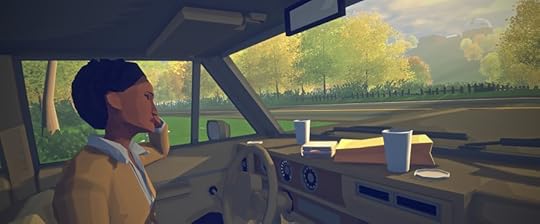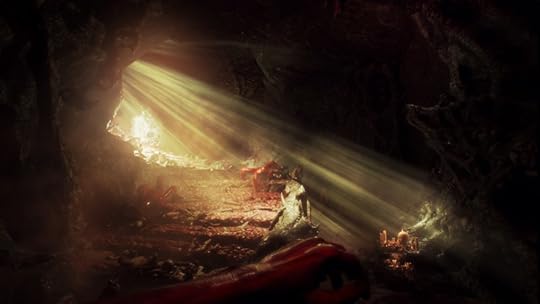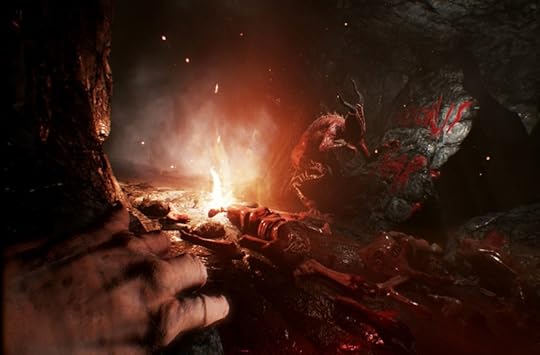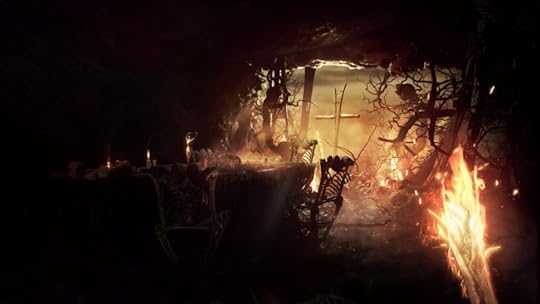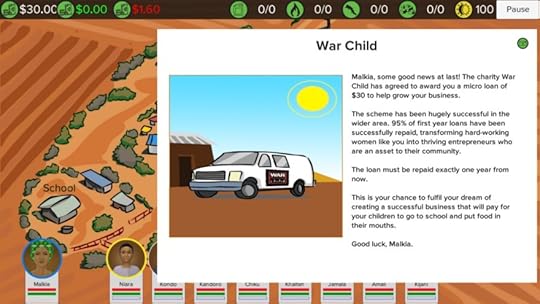Kill Screen Magazine's Blog, page 64
August 31, 2016
At last, the Lynchian detective drama Virginia has a release date
You could be forgiven for not hearing of Virginia before now. The first-person detective game—described by many as a mix of Twin Peaks, The X-Files, and Brendon Chung’s Thirty Flights of Loving (2012)—is something you probably want to be focusing your attention on right now, especially as it’s arrival is right around the corner.
Here’s the deets: Virginia is coming to Windows, Mac, Xbox One, and PlayStation 4 on September 22nd. That’s less than a month away. Maybe it’s time to get up to speed.
a love letter to TV shows that mix the wonderful and the mundane
You can read our previous coverage of Virginia (here and here), and you can even download a demo now, but if you want the condensed version … you play as Anna Tarver, a recently-graduated FBI agent, and her partner special agent Maria Halperin. The pair of you arrive in Kingdom, Virginia to investigate the disappearance of a young boy and from there things get decidedly stranger.
It’s a love letter to TV shows that mix the wonderful and the mundane, and as the investigation takes on more avenues and things become steadily more sinister, you’ll be able to make choices and take actions that shape the two FBI agent’s lives, in addition to the town around them.
It sounds ambitious, and it’s possible that it sounds like the sort of choice-drive adventure game Telltale might put out. If that’s the case, then let me add another line in there: Virginia features no spoken dialogue at all. For audio, the game is relying largely on its score, which was recorded in Prague.
Right now, the team is just finishing up the editing stages, trimming the fat, and keeping the game as tight as possible. In a Kotaku article, developer Jonathan Burroughs expresses his desire for players to get through it in a single sitting, to binge the game like they would a Netflix series.
The comparison isn’t amiss, either, given how Virginia—like a number of Netflix series—has the feel of a ’90s TV show, even having a rural ’90s setting, but delivered two decades late and told via a different medium. If that sounds like your kind of bag then, again, keep your eyes affixed.
Virginia is coming to the Windows, Mac, Xbox One, and PS4 on September 22nd. There’s no price information yet, but there is Steam page with a demo .
The post At last, the Lynchian detective drama Virginia has a release date appeared first on Kill Screen.
Get ready to suffer in Agony’s depraved vision of hell
Who do you think was the first person to start wrecking shit in Hell? It couldn’t have always been a nightmare ditch fraught with furious anger and the scabbed lamentations of sinners. Someone must have made like Saturn in Goya’s famous oil painting and started to devour all their children or something. Once you’ve gone that far you may as well start stuffing people in stone holes and, heck, why not, let’s get some others to start punching each other’s teeth out in the River Styx. Go on, we’ll have a swell time. What’s that? The perfumed scent of decay and fetid matter. Cor, you’re spoiling us now.
Our visions of Hell (and by “our” I mean the West) are plagued by terminal repetition. When you think of Hell you probably see—no wait, let me guess—”horned demons, lakes of fire, and tears of thousands of suffering people.” That’s how Tomasz Dutkiewicz of the Poland-based MadMind Studio describes it. And yeah, he’s right, that is what most of us see, and what we often get in modern depictions of Hell. If we’re talking videogames then DOOM is classically aligned with goat imagery, and then there’s Dark Souls, which picks its hellscapes from the ripe tree of Dante Alighieri’s Inferno and the many paintings and illustrations it has lent itself to.
people wretched with a pain that’s written all over their face
All of these classic references are great—that’s why they’ve lasted so long, why they’ve haunted the religious and non-religious for centuries. But, in creating its own version of Hell, MadMind Studio has decided that to contribute to this ouroboros of demonic imagery isn’t enough. “To induce anxiety, fear, and shivers on your back, you cannot rely only on well-known images,” Dutkiewicz tells me. “You must reach deep into your own mind and get rid of the limitations, drawing inspiration from there. This is the only way to reach deep-seated fear of death and suffering. Agony will draw inspiration mainly from this place.”
Yes, Agony is the name of the game here (quite literally), and it’s agony that is delivered. In its trailers for the game, MadMind has, so far, shown scenes of people wretched with a pain that’s written all over their face, bent back in naked suffering, as well as thumbs pressed into eyeballs, and scraggy sinners screaming from the inside of a flower with petals made of giant arms. There’s an eight-minute trailer that shows some kind of sick corridor made of undulating throats and another “Extended” trailer that’s full of bridges laced with sinew cut between snarled mouths pressed too close to the camera for comfort. The best bit might be a scene of what appears to be condensed body parts whirling in unceremonious unison, as if a donut-shaped granfalloon on a spin cycle.
What is going on in this depiction of Hell, then? The most Dutkiewicz tells me is that the denizens of Agony resemble a cult in that they’re obsessed with the Red Goddess. The reason being that she is the only memory that everyone who enters this Hell has. “Everyone is trying to find her, with hopes for redemption and a way to escape from their faith,” Dutkiewicz said. “People are making unbelievable, almost unreal constructions for her glory, they are worshiping her image and praying to her, with hopes to improve their current position.” The theory these sufferers have is that the Red Goddess designed the place they’re trapped in. And because of that they reason that she knows the way out. It’s not just the people, either. “This concept also [has] a reference in the world of demons,” Dutkiewicz adds. “Those beasts are trying to copy their goddess. They are using all the primitive desires to distract and temp terrified male and females. It’s their specific way to impress the goddess.”
As the player, your role is to find a way to meet the Red Goddess so you can escape. But this is Hell, and nothing is that easy: this is a survival horror game after all. The eight-minute trailer sees Agony resembling the Amnesia series most of all, with a demon hunting the player down, and them having to hide in the dark to avoid whatever malicious plans it had for them. The comparison holds up according to Dutkiewicz. However, Agony goes in a different direction too, as you will be able to fight back—being defenseless is vital to the successful terror of the Amnesia series, so this is a big diversion. This is shown in the trailer as the player picks up a torch and uses the flame to scare away the predator. But this is only the beginning.
the lid is shutting over the hellhole once again
It turns out that the main character has the ability to possess other creatures. “Players will be able to possess simple-minded demons,” Dutkiewicz said. “By using them, they will be able to fight other beasts, and unlock passages. It will often be up to the players what body they are choosing to control, and what kind of gameplay fits them at the moment.” As you go deeper into the abyss, you’ll need to learn to make the most of this ability, becoming more brutal and cunning as the demons do too. There are also story implications behind the possession ability, as Dutkiewicz said: “What makes him so special? Why is he so different than others? This is one of the questions [the main character] is trying to understand and ask [the] Red Goddess.”
MadMind has been keen in recent weeks to show off their work on Agony, giving us a taste of what’s to come. But now the lid is shutting over the hellhole once again. You probably shouldn’t expect to hear too much more on the game until it is out. Listen for the screams.
Agony is coming to PC via Steam in the second quarter of 2017. Find out more on its website.
The post Get ready to suffer in Agony’s depraved vision of hell appeared first on Kill Screen.
Be a magical fox that can change the seasons on September 2nd
Though the strangely-specific genre of “fox adventure game” isn’t exactly lonely this summer, the upcoming platformer Seasons After Fall is determined to assert its individuality. A fox wandering through a forest: good. A fox wandering through a forest in order to collect fragments of every season in order to fulfill a magical ritual: even better. Developed by Swing Swing Submarine and charmingly hand-painted, Seasons After Fall isn’t scared to follow its own ideas.
Switching between seasons is the signature of the game
During his quest for the fragments, the protagonist (i.e. the fox) has one significant advantage over his environment: he can manipulate the seasons, changing spring to fall to winter and back again. Switching between seasons is the signature of the game, as it enables the fox to freeze water to run over, cause plants to grow that can be used as platforms, and other advantages. These puzzles are obstacles, standing in your way as you attempt to complete the ritual.
This ritual is finished by gaining the powers of the Guardians, “gigantic totemic spirits” that correspond to each of the seasons, and who are the keys to completing your quest. You are guided by the spirit that narrated the recent Gamescom trailer, whose hopes rest on the ritual’s successful completion. Her narration gives hints to the nature of the fox, mentioning that the protagonist should “enjoy [their] new body,” and sneaks a peek at the slumbering Guardian of Winter, but gives nothing further away.
Luckily, this won’t take long to arrive: Seasons After Fall is officially being released on September 2nd, though it’s currently available to pre-order for a small discount. That’s certainly much quicker than waiting for the seasons to change.
The post Be a magical fox that can change the seasons on September 2nd appeared first on Kill Screen.
Childhood game ‘The Floor is Lava’ is being turned into a videogame
As a child, imagination turned the familiar and mundane into something more during play. Legos let you create amazing structures and recreate your favorite heroes and cartoons. Battles worthy of their own comic splash pages took place between action figures. A playground wasn’t just baking metal slides and swings; it was a fortress or pirate ship. And the floor wasn’t tiles or wood or carpet, but lava to be avoided at all costs.
If their next game is any indication, the team over at Klei must have really loved that last one.
angry red by the lakes of lava that have replaced the floor
Hot Lava transplants the fluid first-person movement popularized by Mirror’s Edge (2008) from the rooftops to the living room, the school hallways, the gymnasium: familiar places now tinted an angry red by the lakes of lava that have replaced the floor. Touching the molten ground isn’t an option; running and leaping across desks, walls, and beds as an action figure given acrobatic life is your only means to escape.
Fluid traversal is perhaps the most crucial aspect in this subgenre, the thrill of masterful acrobatics from a more innate perspective, and Klei’s flaming gauntlets promise to be tightly-designed playgrounds to leap, wall-run, and swing through. Momentum will be an important variable to consider as massive chasms abound; special surfaces will let you gain incredible speed to leap across these huge gaps.
Hot Lava doesn’t have a release date yet, but will be starting a closed beta soon. You can sign up for the beta here, and follow the game on Steam and Klei’s site.
The post Childhood game ‘The Floor is Lava’ is being turned into a videogame appeared first on Kill Screen.
Carl Burton’s gorgeous GIFs are being turned into a videogame
Shopping malls. Airport bookstores. Hotel lobbies. Carl Burton—the artist and animator behind Serial‘s second season GIFs—is creating a videogame that exploits the “boringness” of these liminal, corporate spaces. Using the foggy, surrealist art style of his GIFs, ISLANDS is a videogame you experience, rather than play.
Anthropologist Marc Augé calls these spaces non-places—”If a place can be defined as relational, historical, and concerned with identity, then a space which cannot be defined as relational, or historical, or concerned with identity will be a non-place,” Augé wrote in Non-Places: An Introduction to Anthropology of Supermodernity (1992). A parking lot is a non-place, too. It’s a place meant to be temporal, to be traveled through. A place that, just by parking in it, a person is in adherence to a set of rules. Anonymity. Augé theorized that entering this sort of non-place strips a person of her “usual determinants.” When passing through a non-space, she’s simply a user of that non-space.
Neutrality in these spaces give them a sort of uncanny quality

Neutrality in these spaces give them a sort of uncanny quality, Burton said. That’s what he’s focusing on with ISLANDS. Burton is aiming to confront the surreal aspects of these spaces, echoing the “strange truth” of non-places Augé uncovered in his research: “The face and voice of a solitude made all the more baffling by the fact that it echoes millions of others,” Augé wrote.
ISLANDS is about making these spaces that feel intuitive and experiential, Burton said. “In ISLANDS, each space is a self-contained scene that you interactively trigger that transforms it into something more surreal, yet strangely functional,” Burton said. Ten environments will be available to explore—among them, a waiting room, a parking lot, a lobby, all in Burton’s gorgeous, minimal art style.
ISLANDS will be released on Mac, Windows, and iOS platforms in fall 2016. Voting for ISLANDS is open on Steam Greenlight. See more of Burton’s work, which include short films and illustrations, on his website.

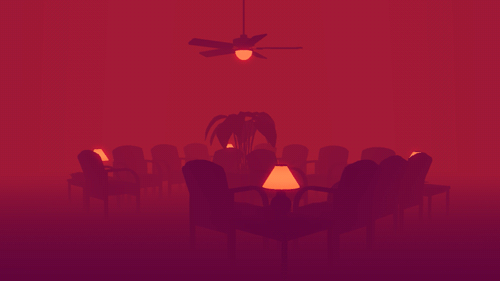
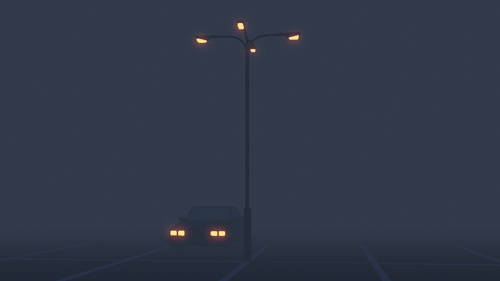
The post Carl Burton’s gorgeous GIFs are being turned into a videogame appeared first on Kill Screen.
Some of Japan’s best artists are reimagining Astro Boy for a card game
Of all the collaborations that the disco and electronic composer Giorgio Moroder has participated in (collaborations that include the likes of Janet Jackson and David Bowie), a joint project with Osaka-based game studio Project Atom to make an Astro Boy digital collectible card game might be the most surprising. But, here we are, and he’s hardly the only big name tied to the project.
In Astro Boy: Edge of Time, currently expected to release early next year, dark forces have destroyed much of the known universe, with who little survived living in eight districts in a floating city called “The Sprawl,” which “exists outside the normal flow of time and space.” Peace exists among the people of The Sprawl until being invaded by the demon king Goa, interrupting the quiet.
Combating this new force and his fleet are classic characters Astro, Magma, and others, assisted by new heroes called “summoners,” able to use cards to “manifest hard light construct versions of those they’ve met, the summoners are able to create entire armies with the flick of their wrists.” Despite repelling Goa’s forces, many heroes were left hurt, including Magma who sleeps in the center of the city, and Astro, who is nowhere to be found. Two years have passed, and no questions have been answered, but now something new has woken up in the Sprawl. “A new era begins in the last city in existence.”

A Kickstarter for Astro Boy: Edge of Time launched recently with some pretty big names tied to it. Asking for $50,000 (USD), the aforementioned Moroder is acting as “guest composer,” writing the game’s theme song. Akira Yamaoka, of Silent Hill fame, is the game’s “sounds creator,” writing the rest of its soundtrack.
a love letter to the mind of its creator
The music—there are two preview tracks on Edge of Time’s Kickstarter page—is a mix of 80s-style new wave and a healthy dose of trance music, sounding kind of like the soundtrack to Mega Man 3 (1990) remastered for 2016. However, it is the game’s art that is most striking and notable.
Despite the name, Edge of Time isn’t a reboot of the Astro Boy manga series (1952); it’s a love letter to the mind of its creator, Osamu Tezuka, and his wide breadth of work and characters. Working in conjunction with Tezuka’s son, Makoto Tezuka, Project Atom is attempting to reintroduce the themes and worlds and Tezuka’s work, but by employing a whole host of famous artists to re-design “every character we can possible get our hands on,” scenario writer Nayan Ramachandran explains in the game’s campaign video.

Some of the seven announced artists are Nekoshowgun, the illustrator behind the design of characters in Lollipop Chainsaw (2012), Hiroya Oku, the manga artist responsible for the Gantz manga series (2000), and Suda 51, CEO of Grasshopper Manufacture, the studio behind Killer 7 (2005) and the upcoming Let It Die.
Of the art shown, new character designs are the most impressive, looking like a composite of Tezuka’s work and the work of Masamune Shirow, the artist and writer of the Appleseed and Ghost in the Shell series (1985 and 1989, respectively). Designs are detailed, colorful, and eclectic, combining futuristic, cyberpunk stylings with more historical, traditional Japanese designs.
Project Atom is seeking $50,000 with its Kickstarter campaign, which ends on September 21. To keep up with the game, you can follow its progress on Twitter. You can also check out this demo.

The post Some of Japan’s best artists are reimagining Astro Boy for a card game appeared first on Kill Screen.
The Wargamer and I
“All play has its rules.”
—Johan Huizinga, Homo Ludens: A Study of the Play Element in Culture (1950)
The first time I encounter the Wargamer, he is militantly editing a Word document and downing an Americano. Hundreds of red marks, crisscrosses, and deleted commas fill his MacBook screen. I make a small quip about how his desktop looks like a battlefield, and the Wargamer hastily explains that the color isn’t his fault, but rather, a courtesy of Microsoft Office. He tells me that he edits game rulebooks professionally, that he’s worked on games about pirates, migraines, and cats. I begin to laugh. I’m deathly allergic to cats, and the idea of someone voluntarily deciding to play an entire game about my nemesis, my furry feline foe, cracks me up.
Let me put my cards on the table. Games aren’t complete gobbledygook to me. As a child I was fed a heavy diet of Cribbage and No Limit Texas Hold’em poker by my parents—two pacifists, who were against military engagement in the Middle East. The only battles my dad fought were at the poker table. Though he taught me at age six how to bet and bluff, board games were never his bailiwick—or mine, until the Wargamer came on the scene.
I have no clue how to prepare for this date or for this wargame
The Wargamer is strategic, smooth, and before too many moons have passed, I start to fall for him. The fall is sudden, steep, and yet, nonviolent. The Wargamer walks to the beat of his own drummer, but he’s never on a warpath. He meditates, retweets @bunnybuddhism, reads Oliver Sacks, and has a sticker that says “Gaming’s Feminist Illuminati” on the back of his MacBook Air. I fall for the Wargamer, because he sculpts sentences and tries to bring order to the words people toss together. You see—I am one of those people, who tosses words together: I write.
When I meet the Wargamer, I am in the throes of researching my Master’s thesis on the Guantánamo Bay Detainee Library. Emails to and from the Department of Defense clog my inbox. My bookshelf is no merry-go-round; Michael Ratner’s The Trial of Donald Rumsfeld (2008), Neil Krishan Aggarwal’s Mental Health in the War on Terror (2015), Dr. Robert H. Wagstaff’s Terror Detentions and the Rule of Law (2013), Joseph Hickman’s Murder at Camp Delta (2015), and A. Naomi Paik’s Rightlessness are strewn across my bed. Weekend fun for me is digging into the Department of Defense’s 1204-page-long Law of War Manual.

The Camp Delta Standard Operating Procedures by the Joint Task Force-Guantánamo (2004)
The Wargamer woos me. He invites me to play Cuba Libre! (2013). It’s a board game co-designed by the former CIA analyst Volko Ruhkne to show the complexity of Fidel Castro’s insurgency. By this time, I’ve told him I research GiTMO, and I take the plunge. I say confidently, “I’m game for your game.”
I can’t help but chuckle. I chuckle, as I try to make sense of the game’s 36-page-long manual. I chuckle, because I’m about to re-enact the Cuban Revolution in what can only be described as a Bernie bubble, a stone’s throw away from Smith College, in Gloria Steinem’s old stomping grounds, where the town’s motto is “caritas, educatio, justitia” (that’s “caring, education, justice” for all you kids who never studied Latin). I chuckle, because I’m going on a date with a dear dimpled boy, who gets his kicks out of reading wargame rulebooks. I chuckle, because after studying Guantánamo for so many months, I still embarrassingly know so little about Cuban politics, jurisprudence, and history. Let’s just say Castro wasn’t on my high school curriculum in South Carolina.
The Wargamer walks to the beat of his own drummer, but he’s never on a warpath
I have no clue how to prepare for this date or for this wargame. I think back to the words of Mary L. Dudziak in War Time (2012), and her declaration that “wartime is assumed to be temporary, but now we find ourselves in an era when American political leaders announce an end to hostilities—“mission accomplished”—but war continues.” A student of languages, I know how to say “war” in Turkish, Arabic, French, and even Pashto, but I realize that I’m not sure what it means. I head to the Oxford English Dictionary for some etymological counsel, but it doesn’t help me much.
Definition of “war” according to the online edition of the Oxford English Dictionary
I turn next to the Late Night Gamer, a YouTube channel run by a Norwegian guy, for some preliminary advice. I click the link and an ominous voice tells me, “Night has come. The family’s gone to bed, so the Night Gamer strikes again.” And it’s when I see the board on the YouTube video that I lose it entirely. I can’t stop laughing. There are red, yellow, green, and blue cylinders; Propaganda and Event cards; discs; die; and of course, factions. This is war. I close my laptop, take out some sourdough starter, and as I knead the dough, I prepare for battle.

The Playbook for Cuba Libre! (2013) by Jeff Grossman and Volko Ruhnke
I make my way to the Wargamer’s home with a cardamom-and jalapeño-infused sourdough loaf in hand. There, waiting for me are three other players, three guys hailing from varying corners of North America. This demographic doesn’t come as too much of a surprise. (On the blog PAXsims, Rex Bryne eloquently reflects on this issue of gender imbalance in the wargaming hobby world.) But no matter—what counts—is that the Wargamer is also the Resident Rule Explainer. He’s focused and clearly on a mission, but there’s no way this dear dimpled twentysomething wants to intimidate or alienate. So even though, at first, I have no idea what I’m doing, and I’m scribbling down words like “victory condition,” “victory track,” “momentum,” and “attack operations” on a piece of college-ruled paper, I’m adrenalized. There’s even a card about Guantánamo Bay.
A playing card from GMT Games’s Cuba Libre! Excerpt taken from the Rules of Play (2013)
Having been raised by a veteran of Manhattan poker clubs, I decide to play the Syndicate (a.k.a. the Mob) and fight to expand “my” casino empire.
Months after playing, I still don’t remember how many casinos I opened or how many cash markers I placed under guerilla markers. I don’t even know who got to play the Guantánamo card. But, as I walk home that November night, I begin to grapple with this idea that a board game can model the strategic quagmires facing different stakeholders in a system. Fulgencio Batista’s Cuban government doesn’t want what the 26 July Guerillas want. The Directorio Revolucionario doesn’t want what the Syndicate wants. All four duke it out on the board. To win a player has to take the motivations and goals of the other factions into account. Ultimately no one wants the same thing. To put it in ludolingo: each faction has a different victory condition.
I pause to think of what Guantánamo might look like as wargame. I briefly escape my books. I take a break from interviews and emails. I think of the journalists trying to track down information, of the habeas corpus lawyers in the military tribunals seeking justice, of the detainees fighting for freedom, and of the guards striving to maintain order. They’re all part of a system that I am trying to decipher from afar.
It is too tempting to gamify the relationship
Under the night sky of Northampton, Massachusetts, the Wargamer gives me a crash course in game mechanics and confesses that his first attempt at designing a game bombed. He tells me that after reading Greg Mortenson’s Three Cups of Tea (2006), he once tried to make a two-player game about porters and Sherpas in Nepal. I fall a bit harder for the Wargamer. I find beauty in the way the Wargamer deciphers each and every rulebook. I see symmetry in what we do: I examine policies and procedures at GiTMO, while he tweaks the structure of fantasy worlds, one rulebook at a time.
The Wargamer and I gradually work our way through a number of the games designed (or co-designed) by Volko Ruhnke, including Labyrinth: The War on Terror, 2001 – ? (2010) and A Distant Plain (2013). The Middle East, the Soviet Union, Afghanistan—I had no idea that there was a sub-genre of board games devoted to modelling conflict in these regions. We debate and debrief game design. The Wargamer plays A Distant Plain (2013) with me and asks his friends, “Would you play a game in which one playable side was the Taliban? Would you ever play as the Taliban if it helped you understand them?”
I have questions of my own. How would we experience Cuba Libre! (2013) differently if we played it with Cuban ex-pats? What would Afghan politicians have to say about the design of A Distant Plain? What strategies could game designers use to introduce more women into the world of wargames? Someday will I be able to design a wargame of my own? Occasionally we get ambitious and tweet questions directly to the Master Wargamer Volko Ruhnke himself.
Labyrinth (2010) is the first wargame that I win outright, and it is also the last time I play with the Wargamer.
We begin one day in May as two wonkish wargamers, and end it, strangers on the street.
I have other battles to fight. Those are his last words. I am swiftly expelled from—what I’ve come to nickname—his Ludoland. It is too tempting to gamify the relationship, to think of the different cards that could have been played. I reflect on the fact that as I delved deeper and deeper into the Wargamer’s world, I forgot to give him a full tour of mine. The thesis chapters not shared, the conversations about Guantánamo not had, they all stack up in my mind like soldiers preparing to go to war. But I am no general.I flee.
Photo of the author’s bookshelf (2016)
I cram my books in a beige roller bag and hop on a bus from the Bernie bubble to Boston.
My research on GiTMO expands in ways I could not have predicted. I dive into the corpus of GiTMO literature. I get into a tangle with the Department of Defense Public Help Web Desk about a series of broken hyperlinks in an important report that was prepared for President Obama back in 2009. I begin a correspondence with a convicted war criminal at the International Criminal Tribunal of the Former Yugoslavia. I have lunch with a law professor, and together we ponder how GiTMO will be taught 50 years from now. I even try a Meal, Ready-to-Eat (MRE), a food ration used by the U.S. military.
It’s a feeble attempt at self-exile.
Wargames follow me.
One day I find myself almost by accident in a bunker-like room with someone, who wants to make a game about the Nuremberg Trials. I later email a coworker at the Harvard Law School a link to a video review by Shut Up and Sit Down of the Virgin Queen (2012), one of the more complicated wargames produced by the popular publisher GMT Games. There’s this great line at the end, where one of the reviewers says, “Let this be a warning to you. If you want to experiment with wargames, just do your homework first.” It gets me everytime. The next week I casually mention my love for another GMT wargame, A Distant Plain (2013), to my new roomies—a rock star all-female team—and they demand that we play. As I start to set up the board, ready to explain the rules myself for the first time, I can’t help but crack a smile.
The post The Wargamer and I appeared first on Kill Screen.
August 30, 2016
If you didn’t get your hands on Overland before, now is your chance
If you’ve been waiting to play Finji’s new game Overland, but didn’t make it into the limited First Access Program, then good news: Overland is now open to the public.
Overland is a tactical survival game in the vein of XCOM but with far more adorable dogs and heartache. The game has you balancing a carload of survivors as you cross the United States, balancing gas shortages and injuries in a board game-like atmosphere. The game has procedurally generated characters with their own quirks and traits, allowing you just enough time to get attached to them before they are viciously murdered by rock-like bug creatures. The dogs, as it happens, are also susceptible to death.
the ability to put backpacks on dogs
The game isn’t done; Overland’s First Access is still in effect—meaning new content is added every month, private developer forums on Trello, and secret surprises and updates for people who are choosing to support the game early. Opening First Access to the general public comes at the same time as an update to the game, including perhaps most importantly, the ability to put backpacks on dogs.
Post-apocalyptic fiction has often been home to dog friends. Mad Max often had a four-legged companion his earlier movies, even if it was usually unceremoniously killed. And there’s the bleak comedic story of A Boy and His Dog (1975). What these movies were ultimately missing, and what Overland brings to the table, is dogs with backpacks. I mean, obviously.
You can find out more about Overland, and join the First Access program, through its website.
The post If you didn’t get your hands on Overland before, now is your chance appeared first on Kill Screen.
One of the most authentic hacking simulators is getting an expansion
The videogame and hacking simulator Hacknet has been praised over and over again for its dedication to realism since it arrived last year. The whole game is viewed through an interface, and the player’s tasks are all as close to actual hacking as possible, using real unix commands. It’s not a game that’s interested in babying you, but that’s all the more appropriate for the subject matter. In the original game, you were tasked posthumously by another hacker to look into his own death, piecing the plot together through careful investigation and lines of code. Now, Hacknet is getting even more mystery with the expansion Hacknet Labyrinths.
it’s not a game that’s interested in babying you
Labyrinths is another chapter in Hacknet’s original story, but it’ll introduce new tools and programs to use within the new missions, which will be more complex than the vanilla. You’ll join a team of hackers and pull off dangerous data heists; an IRC style chat client will be used to communicate within the team, which will help on missions that may require cooperation and patience as opposed to brute force.
Since Labyrinths fits in with Hacknet’s main plot, it will tie into your original tasks with more than just the new content. Hints of Labyrinths’s story can be found in the main game, which serve to further connect the additional missions to the overall plot. There’s a whole new network to explore, and mysteries behind the inscrutable group that recruited you and your team to solve, but the game at its heart won’t stray far from the established formula, promising a lot more good ol’ hacking.
The new content will be 3-4 hours of brand new digital hijinks, to be released sometime at the end of 2016 for Windows, Mac, and Linux. If you were looking for the opportune moment to take up hacking, now’s your chance.
You can buy Hacknet on Steam here .
The post One of the most authentic hacking simulators is getting an expansion appeared first on Kill Screen.
Malkia, a game about the struggles of an African businesswoman
HELP: The Game is a recent project that saw 11 videogame studios—including Angry Birds creator Rovio and the studio behind the upcoming Dead Island 2, Sumo Digital—team up with the WarChild organization. The idea was for each studio to design a game that could then be bundled and sold together. All the earnings from the game bundle go directly to aid African children.
Out of the games in that bundle, one of those to stand out is called Malkia, and was made by Sports Interactive Studios. It’s set in the imaginary world of Kovi but takes real-world inspiration from countries such as Uganda, Rwanda, and the Democratic Republic of Congo. You play as the titular Malkia, who is a mother with eight children trying to build her own business by travelling “to nearby villages to buy and sell goods.” She does this in order to feed her family and hopefully afford to get them a decent education. As you might imagine, none of this is made easy: “It can take days to travel to some of the villages, to buy some coal or other goods to then re-sell in your own village, with lots of pitfalls along the way,” reads the description.
“It was something that moved me a lot”
Luckily, you’re not completely alone, as the government in the game will help to pay for some of the costs of your children’s’ education. You also have the option of sending your kids off to perform errands that may last a few days, however, nothing is without its consequences, since there is the chance of getting them expelled from their school.
Malkia draws directly from stories of the people that WarChild foundation has helped. According to one of the studio’s representatives, the team got the idea for the game when they visited some of the African countries the organization aids, where men and women start their own businesses with micro-loans from the foundation as low as $50. “It was something that moved me a lot when I saw some of them—aid that can lead to greater things, with a very high rate of the micro loans being paid back, which then leads to more loans being possible,” said the representative.
To try to capture the real people and culture that Malkia is inspired by, Sports Interactive recorded traditional West African music to accompany the game. The art team also decided to give the game’s characters and landscapes a hand-drawn look in order to give the game more of a local feel.
Malkia is currently available for purchase in WarChild’s HELP: The Game bundle. Priced at $14.99, it includes 10 other games with all the collection’s profits going straight to children in need.
The post Malkia, a game about the struggles of an African businesswoman appeared first on Kill Screen.
Kill Screen Magazine's Blog
- Kill Screen Magazine's profile
- 4 followers


